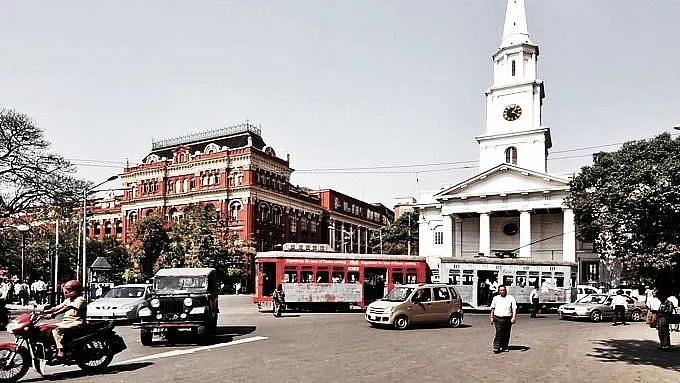Big cities elicit comparison. The finest aspects of a place, and at times the worst, are on display during the celebration of festivals. In a way, an entire city is judged by how its popular festivals play out.
This is the season when critics and analysts are at their vitriolic best, even though social media is abuzz with the season’s greetings and best wishes. This year, too, witnessed a lot of righteous anger over the celebration of the Ganpati festival in Mumbai, the Durga Pujo in Kolkata and Diwali in Delhi. It’s almost Christmas now, and there will be much fanfare in well-known pockets of several cities, such as Santhome in Chennai, the Brigade Road in Bangalore, and Bow Barracks, the Anglo-Indian hub in Kolkata.
But how fair is it to judge cities over such pro tem notions? Or to pit them against each other through sample surveys? Which city has what, that the other does not? Where does its soul lie? What defines it and sets its character? What is it that makes a city memorable?
Though every individual would have a personal, extremely subjective opinion about any place, a few general observations may not be so questionable. For example, who can deny that Bangalore has wonderful weather almost all through the year? Or that New Delhi probably has the largest collection of heritage structures within one metropolis. Likewise, Chennai’s lively sabha culture is unparalleled, and so is Mumbai’s vada pav.
Kulhad Chai Meets Robindro Shongeet
Kolkata, too, has many such remarkable attributes, but very little of the hype. On the ubiquitous blue-and-yellow bus rattling along roads that cut through the green Maidan, you will encounter the loudmouth as well as the subtle intellectual. The kulhad chai dished out to you on a footpath will surely be accompanied by expletives hurled at hurrying passersby. But listen carefully, and you may also hear Robindro Shongeet emanating out of one of the dilapidated, overhanging balconies.
The joy one gets out of a simple plate of luchi mangsho or maach bhaat on Navami is doubtless matched in passion by the sorrow felt at Ma Durga’s farewell on Dashami. Nowhere else in India will you find the average Joe to be equally crazy about football and cricket. And the tram ambling along at its own unhurried pace, as an elderly woman looks on from the second-storey window of her tumbledown, has a certain charm about it. Neither the tram nor the lady will be too bothered about the sports bikes and suave sedans that are passing them by.
The tidiness at public spaces, such as the Rabindra Sarovar and the Eco Park, happily compliments the puzzling cleanliness of footpaths and lanes in crowded market areas such Gariahat and New Market – puzzling because of the general misconception that Kolkata wears an unwashed look.
The truth is it has some dirty pockets. As do Bangalore, Delhi and Mumbai. The closure of open vats and an aggressive public awareness campaign has borne results, the true value of which can be understood by anyone who has spent a considerable amount of time living in Kolkata as well as any other Indian city.
A Great Equaliser
There is little doubt that Kolkata is one of the safest cities in India. Moral policing and ultra-conservatism are rightly frowned upon. A gentle, confident liberalism flows in the air. Of course, there is no perfect city. But what Kolkata lacks in terms of opportunity is well made up by bundles of generosity. The sweaty weather is set off by an affordable cost of living. The concrete jungle can be easily left behind for tourist spots at Digha-Mandarmani, Bakhali, Sagar, Sunderbans, Santiniketan, Bankura or Jhargram, all of which are just a few hours away from the city.
The much-criticised work culture sees to it that the hoity-toity are often snubbed by their domestic help or the clerical staff at a government establishment. They are often forced to rub shoulders with the working class. Perhaps it is an equaliser, this culture of questioning and demanding. It affects performance, but what is the ideal – efficiency or human dignity? Rather than creating an army of mechanical workers, this city creates human beings who are alive.
It creates men and women who are aware, who play, read, paint, sing and dance. Kolkata lets you eat and sleep to your heart’s content, without a worry in the world.
So, what is it that makes a city memorable? The answer may lie in the average mores and attitudes of its people, or in the language and culture that one encounters, or in the unique ethnic mix of the place. It may be drawn from the nature and ease of public transport on offer, or from the buildings and open spaces, shops and markets, sights and sounds that grow to become familiar. Or, it may just be a certain quality that cannot be defined. A quality that passes from a city’s air and water to its people, transforming them into something that the great big city can perhaps live with and tolerate.
(Atul Vishwanathan is an IPS officer of the West Bengal cadre. This is an opinion piece and the views expressed above are the author’s own. The Quint neither endorses nor is responsible for the same.)
